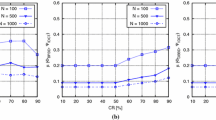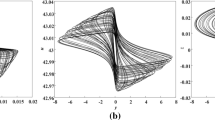Abstract
Internet of Things (IoT) becomes a fabulous domain as its ruling spreads throughout the universal domains. In IoT, Wireless Sensor Network (WSN) is the commonly used technology today. But when dealing with WSN, it is highly prone to data security and energy efficiency during data transmission, due to interference in transmission path and transmission of big size of data. Existing mechanisms have used multiple accessing techniques for effective transmission but failed in transmission due to less memory storage of sensor node and also lacked in preserving originality of the compressed data due to bad compression ratio. So, to deal with this scenario, a compressive slender penetrative etiquette is designed as our proposed work for effective transmission of data in WSNs that attains high data transmission rate with diminishing of interference and attenuation. The optimal way for transferring data with limited energy is achieved with a compressive sensing technique called Chaotic Demodulation Stratagem. It makes use of a Mock Random Generator which generates a high-speed sequence which multiplies the signal in the analog domain. The obtained output from the low pass filter is then supposed to sampling process at a rate lower than the Nyquist rate. Similarly, the other end of the signal reconstruction is done by means of the Convex relaxation iterative algorithm.















Similar content being viewed by others
References
Al-Hamadi H, Chen R (2013) Redundancy management of multipath routing for intrusion tolerance in heterogeneous wireless sensor networks. IEEE Trans Netw Serv Manag 10(2):189–203
Amadeo M, Molinaro A, Ruggeri G (2013) E-CHANET: routing, forwarding and transport in Information-Centric multihop wireless networks. Comput Commun 36(7):792–803
Amini N, Vahdatpour A, Xu W, Gerla M, Sarrafzadeh M (2012) Cluster size optimization in sensor networks with decentralized cluster-based protocols. Comput Commun 35(2):207–220
Bao F, Chen R, Chang M, Cho JH (2012) Hierarchical trust management for wireless sensor networks and its applications to trust-based routing and intrusion detection. IEEE Trans Netw Serv Manage 9(2):169–183
Bara’a AA, Khalil EA (2012) A new evolutionary based routing protocol for clustered heterogeneous wireless sensor networks. Appl Soft Comput 12(7):1950–1957
Batra PK, Kant K (2016) LEACH-MAC: a new cluster head selection algorithm for wireless sensor networks. wireless Netw 22(1):49–60
Brar GS, Rani S, Chopra V, Malhotra R, Song H, Ahmed SH (2016) Energy efficient direction-based PDORP routing protocol for WSN. IEEE Access 4:3182–3194
Butun I, Morgera DS, Sankar R (2014) A survey of intrusion detection systems in wireless sensor networks. IEEE Commun Surv Tutor 16(1):266–282
Corke P, Wark T, Jurdak R, Wen H, Valencia P, Moore D (2010) Environmental wireless sensor networks. Proc IEEE 98(11):1903–1917
Dahnil PD, Singh YP, Ho CK (2012) Topology-controlled adaptive clustering for uniformity and increased lifetime in wireless sensor networks. IET Wireless Sens Syst 2(4):318–327
Ganesh S, Amutha R (2013) Efficient and secure routing protocol for wireless sensor networks through SNR based dynamic clustering mechanisms. J Commun Netw 15(4):422–429
Gu X, Jiguo Y, Dongxiao Y, Wang G, Lv Y (2014) ECDC: an energy and coverage-aware distributed clustering protocol for wireless sensor networks. Comput Electr Eng 40(2):384–398
Guo Q, Li X, Xu G, Feng Z (2017) MP-MID: multi-protocol oriented middleware-level intrusion detection method for wireless sensor networks. Future Gener Comput Syst 1(70):42–47
Hassanzadeh A, Zhaoyan X, Stoleru GG, Polychronakis M (2016) PRIDE: a practical intrusion detection system for resource constrained wireless mesh networks. Comput Secur 62:114–132
Huang JY, Liao IE, Chung YF, Chen KT (2013) Shielding wireless sensor network using Markovian intrusion detection system with attack pattern mining. Inform Sci 231:32–44
Ibriq J, Mahgoub I (2014) HIKES: hierarchical key establishment scheme for wireless sensor networks. Int J Commun Syst 27(10):1825–1856
Jin RC, Gao T, Zou JY, Wang LD (2013) Passive cluster-based multipath routing protocol for wireless sensor networks. Wireless Netw 19(8):1851–1866
Karlof C, Wagner D (2013) Secure routing in wireless sensor networks: attacks and countermeasures. Ad Hoc Netw 1(2):293–315
Lasla N, Derhab A, Ouadjaout A, Bagaa M, Challal Y (2014) SMART: secure multi-pAths routing for wireless sensor networks. In International Conference on Ad-Hoc networks and wireless. Springer, Cham, pp 332–345
Lee JS, Kao TY (2016) An improved three-layer low-energy adaptive clustering hierarchy for wireless sensor networks. IEEE Internet Things J 3(6):951–958
Liao Y, Qi H, Li W (2013) Load-balanced clustering algorithm with distributed self-organization for wireless sensor networks. IEEE Sens J 13(5):1498–1506
Newell A, Yao H, Ryker A, Ho T, Nita-Rotaru C (2015) Node-capture resilient key establishment in sensor networks: design space and new protocols. ACM Comput Surv (CSUR) 47(2):24
Ouellette W, Getinet W (2016) Remote sensing for marine spatial planning and integrated coastal areas management: achievements, challenges, opportunities and future prospects. Remote Sens Appl 4:138–157
Pantazis NA, Nikolidakis SA, Vergados DD (2013) Energy-efficient routing protocols in wireless sensor networks: a survey. IEEE Commun Surv Tutor 15(2):551–591
Sanz D, Barrientos A, Garzón M, Rossi C, Mura M, Puccinelli D, Puiatti A et al (2013) Wireless sensor networks for planetary exploration: experimental assessment of communication and deployment. Adv Space Res 52(6):1029–1046
Shamshirband S, Anuar NB, Kiah M, Rohani VA, Petković D, Khan AN (2014) Co-FAIS: cooperative fuzzy artificial immune system for detecting intrusion in wireless sensor networks. J Netw Comput Appl 42:102–117
Tsianos KI, Rabbat MG (2013) Multiscale gossip for efficient decentralized averaging in wireless packet networks. IEEE Trans Signal Process 61(9):2137–2149
Tyagi S, Kumar N (2013) A systematic review on clustering and routing techniques based upon LEACH protocol for wireless sensor networks. J Netw Comput Appl 36(2):623–645
Wang Y, Chen H, Wu X, Shu L (2016) An energy-efficient SDN based sleep scheduling algorithm for WSNs. J Netw Comput Appl 1(59):39–45
Yan H, Zhang Y, Pang Z, Da Li X (2014) Super frame planning and access latency of slotted MAC for industrial WSN in IoT environment. IEEE Trans Industr Inform 10(2):1242–1251
Author information
Authors and Affiliations
Corresponding author
Additional information
Publisher's Note
Springer Nature remains neutral with regard to jurisdictional claims in published maps and institutional affiliations.
Rights and permissions
About this article
Cite this article
Reddy, V., Gayathri, P. Energy efficient data transmission in WSN thru compressive slender penetrative etiquette. J Ambient Intell Human Comput 11, 4681–4693 (2020). https://doi.org/10.1007/s12652-020-01724-6
Received:
Accepted:
Published:
Issue Date:
DOI: https://doi.org/10.1007/s12652-020-01724-6




